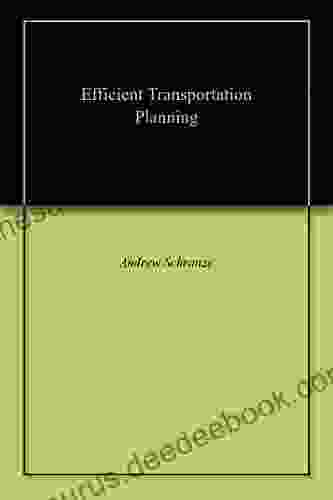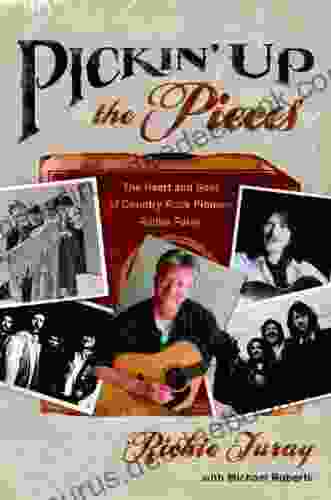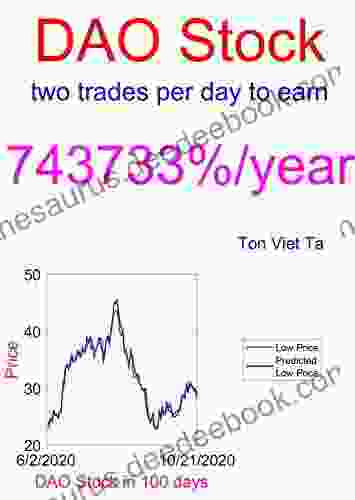Efficient Transportation Planning: A Comprehensive Guide by Rachel Wells

Efficient transportation planning is rooted in several fundamental principles:
a. Mobility for All:Transportation systems should provide accessible and affordable mobility for all citizens, regardless of age, ability, or income level.
b. Sustainability:Transportation planning must prioritize environmentally sustainable solutions that reduce carbon emissions, promote clean energy, and minimize air and noise pollution.
4.7 out of 5
| Language | : | English |
| File size | : | 3077 KB |
| Text-to-Speech | : | Enabled |
| Screen Reader | : | Supported |
| Enhanced typesetting | : | Enabled |
| X-Ray for textbooks | : | Enabled |
| Print length | : | 344 pages |
| Lending | : | Enabled |
c. Economic Efficiency:Transportation systems should be designed to maximize the movement of goods and people with minimal cost and delay.
d. Safety:Safety is paramount in transportation planning. Systems should prioritize measures to reduce accidents, fatalities, and injuries.
e. Equity:Transportation planning should promote equitable access to mobility for all communities, including underserved and marginalized populations.
Efficient transportation planning involves a comprehensive process that typically includes the following steps:
a. Data Collection and Analysis:The planning process begins with gathering data on existing transportation systems, traffic patterns, demographics, land use, and economic trends.
b. Problem Identification:Data analysis helps identify key problems and challenges in the transportation system, such as congestion, inefficient routes, or lack of access.
c. Goal Setting:Clear and quantifiable goals are established based on the identified problems. These goals could include reducing travel time, improving air quality, or enhancing safety.
d. Alternative Development:Various transportation solutions are developed to address the identified problems and achieve the set goals. These alternatives may include road improvements, public transit expansion, or pedestrian and cycling infrastructure.
e. Evaluation and Selection:The developed alternatives are evaluated based on their potential impact on mobility, safety, sustainability, economic efficiency, and equity. The most feasible and effective solution is then selected.
f. Implementation and Monitoring:The selected solution is implemented, and its progress is monitored regularly to ensure it meets the desired outcomes. Adjustments can be made as needed based on ongoing evaluation.
To ensure the development and implementation of efficient transportation systems, best practices should be followed:
a. Community Engagement:Engaging with the community throughout the planning process is crucial. Public input helps identify local needs, concerns, and preferences.
b. Multimodal Integration:Transportation systems should integrate various modes of transportation, including public transit, walking, cycling, and driving. Intermodal connectivity improves mobility and reduces dependency on single modes.
c. Demand Management:Implementing demand management strategies, such as congestion pricing, carpooling, and telecommuting programs, can help reduce traffic congestion and improve air quality.
d. Smart Infrastructure:Utilizing smart technologies, such as traffic sensors, adaptive traffic signals, and real-time information systems, can optimize traffic flow and improve safety.
e. Environmental Considerations:Transportation planning should prioritize environmentally sustainable solutions, such as encouraging electric vehicles, promoting public transit, and enhancing pedestrian and cycling infrastructure.
f. Long-Term Perspective:Transportation planning should adopt a long-term perspective to anticipate future mobility needs, land use changes, and technological advancements.
Numerous cities worldwide have successfully implemented efficient transportation planning strategies. Here are a few notable examples:
a. Singapore:Singapore's comprehensive transportation system includes a highly developed public transit network, efficient traffic management systems, and a congestion pricing scheme.
b. Copenhagen:Copenhagen has prioritized cycling and pedestrian infrastructure, making it one of the most cycle-friendly cities globally. The city's transportation plan focuses on promoting active mobility and reducing carbon emissions.
c. Barcelona:Barcelona's transportation system is characterized by a strong emphasis on public transit, pedestrianization, and urban regeneration. The city has successfully integrated various modes of transportation and implemented innovative mobility solutions.
The future of transportation planning is shaped by emerging trends such as:
a. Electric and Autonomous Vehicles:Technological advancements are driving the adoption of electric and autonomous vehicles, which have the potential to transform mobility patterns and reduce emissions.
b. Shared Mobility:Ride-sharing, car-sharing, and other shared mobility services are becoming increasingly popular, offering flexible and cost-effective transportation options.
c. Mobility as a Service (MaaS):The concept of MaaS integrates various modes of transportation and mobility services into a single platform, providing seamless and personalized mobility solutions.
d. Data-Driven Planning:Transportation planning is becoming increasingly data-driven, with real-time data collection and analysis used to optimize systems and inform decision-making.
Efficient transportation planning is essential for creating sustainable, equitable, and livable cities. By understanding the principles, processes, and best practices of transportation planning, cities can develop transportation systems that meet the needs of their residents, enhance economic growth, and create a positive impact on the environment. As technology and mobility patterns evolve, it is imperative for transportation planning to remain adaptable and innovative to meet the challenges and opportunities of the future.
4.7 out of 5
| Language | : | English |
| File size | : | 3077 KB |
| Text-to-Speech | : | Enabled |
| Screen Reader | : | Supported |
| Enhanced typesetting | : | Enabled |
| X-Ray for textbooks | : | Enabled |
| Print length | : | 344 pages |
| Lending | : | Enabled |
Do you want to contribute by writing guest posts on this blog?
Please contact us and send us a resume of previous articles that you have written.
 Book
Book Novel
Novel Page
Page Chapter
Chapter Text
Text Reader
Reader E-book
E-book Magazine
Magazine Sentence
Sentence Bookmark
Bookmark Glossary
Glossary Bibliography
Bibliography Foreword
Foreword Preface
Preface Footnote
Footnote Scroll
Scroll Tome
Tome Bestseller
Bestseller Classics
Classics Narrative
Narrative Biography
Biography Autobiography
Autobiography Narrator
Narrator Character
Character Catalog
Catalog Card Catalog
Card Catalog Borrowing
Borrowing Stacks
Stacks Research
Research Lending
Lending Reserve
Reserve Academic
Academic Reading Room
Reading Room Interlibrary
Interlibrary Literacy
Literacy Study Group
Study Group Awards
Awards Reading List
Reading List Book Club
Book Club Theory
Theory P 38 National Association
P 38 National Association Matt Mikalatos
Matt Mikalatos Cgp Books
Cgp Books Elizabeth Laird
Elizabeth Laird Patricia Cornwell
Patricia Cornwell Sandi Lynn
Sandi Lynn Diane Stanley
Diane Stanley Star Edwards
Star Edwards Ben Joel Price
Ben Joel Price Alex Hollings
Alex Hollings Uncertain Commons
Uncertain Commons Juan Burgos
Juan Burgos Rob Hargreaves
Rob Hargreaves Juliette Adam
Juliette Adam Helen Hunt Jackson
Helen Hunt Jackson Dennis C Brewer
Dennis C Brewer Scott Skinner Thompson
Scott Skinner Thompson James A Caporaso
James A Caporaso Michael Lai
Michael Lai Scott La Counte
Scott La Counte
Light bulbAdvertise smarter! Our strategic ad space ensures maximum exposure. Reserve your spot today!

 Anthony WellsExploring the Depths of Human Desire and Despair in "The Night of the Iguana"...
Anthony WellsExploring the Depths of Human Desire and Despair in "The Night of the Iguana"... Art MitchellFollow ·16.3k
Art MitchellFollow ·16.3k Ira CoxFollow ·9.4k
Ira CoxFollow ·9.4k George OrwellFollow ·17.5k
George OrwellFollow ·17.5k Alexandre DumasFollow ·18.8k
Alexandre DumasFollow ·18.8k Dwight BellFollow ·19k
Dwight BellFollow ·19k Jon ReedFollow ·16.4k
Jon ReedFollow ·16.4k Lawrence BellFollow ·11.8k
Lawrence BellFollow ·11.8k Theodore MitchellFollow ·12.8k
Theodore MitchellFollow ·12.8k

 Gary Reed
Gary ReedWeb to Web for Beginners: A Comprehensive Guide to...
In today's interconnected world, websites...

 Elliott Carter
Elliott CarterThe Moon Is Down: John Steinbeck's Poignant Portrait of...
In the annals of literature, John...

 Dalton Foster
Dalton FosterMark The Mechanic: The Incredible Story Of A Young...
In the vibrant realm of robotics, where...

 Fred Foster
Fred FosteriPhone 13 Pro Max User Guide: Everything You Need to Know
The iPhone 13 Pro Max...

 Rodney Parker
Rodney ParkerPope John Paul II: The Pocket Giant Who Inspired Millions
Pope John Paul II, or...
4.7 out of 5
| Language | : | English |
| File size | : | 3077 KB |
| Text-to-Speech | : | Enabled |
| Screen Reader | : | Supported |
| Enhanced typesetting | : | Enabled |
| X-Ray for textbooks | : | Enabled |
| Print length | : | 344 pages |
| Lending | : | Enabled |











